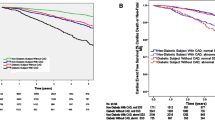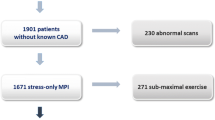Abstract
This survey gives an overview of the methodology of thallium-201 lung/heart uptake ratios often used as an independent factor in the assessment of patients with coronary artery disease undergoing myocardial perfusion scintigraphy. Different techniques have been used in the past. The most sensitive method is one which calculates a lung/heart ratio from scintigraphy obtained immediately after cessation of exercise. If single photon emission tomography (SPET) is routinely performed the anterior projection of the data set obtained during tomographic acquisition should be used in preference to a separate planar anterior static images recorded before or after the SPET procedure. The lung/heart ratio is useful as a prognostic indicator of outcome as it accurately mimics the degree of left ventricular dysfunction. With the increasing popularity of pharmacological stress testing there is evidence that this ratio still offer valid information. Additional work in this field is nevertheless required to further confirm this observation. In routine clinical practice, the lung/heart ratio should help and enable physicians to prioritise patients for urgent intervention.
Similar content being viewed by others
References
Bailey IK, Griffith LSC, Rouleau J, Strauss HW, Pitt B (1977) Thallium-201 myocardial perfusion imaging at rest and during exercise. Comparative sensitivity to electrocardiography in coronary artery disease. Circulation 55:79
Bingham JB, McKusick KA, Strauss HW, Boucher CA, Pohost GM (1980) Influence of coronary artery disease on pulmonary uptake of thallium-201. Am J Cardiol 46:821–826
Boucher CA, Zir LM, Bellar GA, Okada RD, McKusick KA, Strauss HW, Pohost GM (1980) Increased lung uptake of thallium-201 during exercise myocardial imaging: clinical, hemodynamie and angiographic implications in patients with coronary artery disease. Am J Cardiol 46:189–196
Brown KA, Boucher CA, Okada RD, Strauss HW, Pohost GM (1984) Quantification of pulmonary thallium-201 activity after peak upright exercise in normal persons: importance of peak heart rate and propranolol usage in defining normal values. Am J Cardiol 53:1678–1682
Bureau JF, Galliard JF, Grainer R, Olliver JP (1987) Diagnostic and prognostic criteria of chronic left ventricular failure obtained during exercise 201Tl imaging. Eur J Nucl Med 12:613–616
Chouraqui P, Rodrigues EA, Berman DS, Maddahi J (1990) Significance of dipyridamole-induced transient dilatation of the left ventricle during thallium-201 scintigraphy in suspected coronary artery disease. Am J Cardiol 66:689–694
Fintel DJ, Links JM, Brinker JA, Frank TL, Becker LC (1985) Comparison of tomography and planar thallium imaging for identification of disease in individual coronary arteries (abstract). Circulation (Suppl III)III–137
Gibson RS, Watson DD, Carbello BA, Holt ND, Bellar GA (1982) Clinical implications of increased lung thallium-201 during exercise scintigraphy weeks after myocardial infarction. Am J Cardiol 49:1586–1593
Gill JB, Ruddy TD, Newell JB, Finkenstein DM, Strauss HW, Boucher CA (1987) Prognostic importance of thallium uptake by lung during exercise in coronary artery disease. New Engl J Med 317:1485–1489
Gracia EV, Van Train K; Maddahi J, Areeda J, Waxman A, Berman DS (1985) Quantification of rotational thallium-201 myocardial tomography. J Nucl Med 26:17–26
Homma S, Kaul S, Boucher CA (1987) Correlates of lung/heart ratios of thallium-201 in coronary artery disease. J Nucl Med 28:1531–1535
Ilmer B, Reijs AEM, Fioretti P, Reiber JHC (1991) Comparative study of three different approaches on estimation of the lung-heart ratio in thallium-201 scintigrams in relation to the extent of coronary artery disease and left ventricular function. Eur J Nucl Med 18:252–258
Iskandrian AS, Heo J, Ngyen T, Lyons E, Paugh E (1990) Left ventricular dilatation and pulmonary thallium uptake after single photon emission computer tomography using thallium-201 during adenosine-induced coronary hyperemia. Am J Cardiol 66:807–811
Jain D, Lahiri A, Raftery EB (1990) Clinical and prognostic significance of lung thallium uptake on rest imaging in acute myocardial infarction. Am J Cardiol 65:154–159
Kahn JK, Carry MM, McGhie I, Pippin JJ, Akers MS, Corbett JR (1989) Quantitation of post exercise lung thallium-201 uptake during single photon emission computed tomography. J Nucl Med 30:288–294
Kaul S, Cheslar DA, Okada RD, Boucher CA (1987) Computer versus visual analysis of exercise thallium-201 imaging: a critical appraisal in 325 patients with chest pain. Am Heart J 114:1129–1137
Kaul S, Finkelstein DM, Homma S, Leavitt M, Okada RD, Boucher CA (1988) Superiority of quantitative exercise thallium-201 variables in determining long term prognosis in ambulatory patients with chest pain: a comparison with cardiac catheterization. J Am Coll Cardiol 12:25–35
Khawja-Al IM, Lahiri A, Rodrigues EA, Heber EM, Raftery EB (1988) Clinical significance of exercise induced pulmonary uptake of thallium-201 in uncomplicated myocardial infarction. Am J Card Imag 2:135–141
Kurata C, Tawarahara K, Taguchi T, Sakata K, Yamazaki N, Naitoh Y (1991) Lung thallium-201 uptake during exercise emission computer tomography. J Nucl Med 32:417–423
Kushner FG, Okada RD, Kirstenbaum HD, Boucher CA, Strauss HW, Pohost GM (1981) Lung thallium-201 after stress testing in patients with coronary artery disease. Circulation 63:341–347
Lahiri A, Spencer J, Crawley JW, Raftery EB (1982) Pulmonary uptake of thallium-201 in acute pulmonary oedema. Br J Radiol 55:460–462
Lahiri A, O'Hara MJ, Bowles MJ, Crawley JCW, Raftery EB (1984) Influence of left ventricular function and severity of coronary artery disease on exercise-induced pulmonary thallium uptake. Int J Cardiol 5:475–490
Levin OR, Mellins RB, Senior RM, Fishman AP (1967) The application of Starling's law of capillary exchange to the lungs. J Clin Invest 46:934–944
Levy R, Rozanski A, Berman D, Gracia E, Train KV, Maddahi J, Swan HJC (1983) Analysis of the degree of pulmonary thallium washout after exercise in patients with coronary artery disease. J Am Coll Cardiol 2:719–728
Liu P, Kiess M, Okada RD, Strauss HW, Block PC, Pohost GM, Boucher CA (1985) Increased thallium lung uptake after exercise in isolated left anterior descending coronary artery disease. Am J Cardiol 55:1469–1473
Mannting F (1990) A new method for quantification of pulmonary thallium uptake in myocardial SPELT studies. Eur J Nucl Med 16:213–222
Maublant J, Cassagnes J, Lejaunne JJ, Mestas D, Veyre A, Jallut H, Meyneil G (1982) A comparison between conventional scintigraphy and emission tomography with thallium-201 in the detection of myocardial infarction: concise communication. J Nucl Med 23:204–208
Miller DD, Kaul S, Strauss HW, Newell JB, Okada RD, Boucher CA (1988) Increased exercise thallium-201 lung uptake: a non invasive prognostic index in two vessel coronary artery disease. Can J Cardiol 4:270–276
Nishimura S, Verani MS (1990) Quantitative comparison of thallium uptake during adenosine and exercise SPECT in coronary artery disease (abstract). Circulation 82:III-732
Nishimura T, Uehara T, Hayashida K, Kozuka T, Saito M, Sumiyoshi T (1987) Quantitative assessment of thallium myocardial washout rate: importance of peak heart rate and lung thallium uptake in defining normal values. Eur J Nucl Med 13:67–71
Nohara R, Kambara H, Suzuki Y, Tamaki S, Kadota K, Kawai L, Tamaki N, Torizuka K (1984) Stress scintigraphy using single photon emission computed tomography in the evaluation of coronary artery disease. Am J Cardiol 53:1250–1254
Nordrehaug JE, Danielsen R, Vik-Mo H (1990) Physiological inverse relationship between heart rate and thallium-201 lung uptake, clearance and lung/myocardial uptake ratio. Eur Heart 711:628–633
Okada RD, Dai Y, Boucher CA, Pohost GM (1984) Significance of increased lung thallium-201 activity on serial cardiac images after dipyridamole treatment in coronary artery disease. Am J Cardiol 53:470–475
Reisman S, Klepser C, Vaugeois JC, Burgess C, Chandramouly B (1988) Dipyridamole induced increase in pulmonary thallium uptake: a marker of global transit left ventricular dysfunction in patient unable to exercise. J Am Coll Cardiol 11:214A
Ritchie JL, Tobbaugh GB, Hamilton GW, Gould KL, Narahara K, Murray J, Williams D (1977) Myocardial imaging with thallium-201 at rest and during exercise: comparison with coronary arteriography and rest and exercise electrocardiography. Circulation 56:66
Ritchie JL, Williams DL, Harp G, Stratton JL, Caldwell JH (1982) Transaxial tomography with thallium-201 for detecting remote myocardial infarction. Comparison with planar imaging. Am J Cardiol 50:1236–1241
Rothendler JA, Boucher CA, Strauss HW, Pohost GM, Okada RD (1985) Decrease in the ability to detect elevated lung thallium due to delay in commencing imaging after exercise. Am Heart J 110:830–835
Slutsky RA (1984) Thallium scintigraphy: relationship to pulmonary fluid volumes during left atrial hypertension and acute release of pressure. Invest Radiol 19:510–516
Tamaki N, Yoshiharu Y, Yamamoto K, Maeda H, Mukai T, Fujita T, Minato K, Ito H, Ishi Y, Torizuka K, Kanbare H, Kawai C (1981) Lung uptake of thallium-201 on resting myocardial imaging in assessment of pulmonary oedema. Jpn J Nucl Med 18:159–166
Tamaki N, Yonekura Y, Mukai T, Kodama S, Kadota K, Kambara H, Kawai L, Torizuka K (1984) Stress thallium-201 transaxial emission computed tomography: quantitative versus qualitative analysis for evaluation of coronary artery disease. J Am Coll Cardiol 4:1213–1221
Villanueva ITS, Watson DD, Smith WH, Kaul S, Varma SK, Beller GA (1989) Significance of increased lung/heart ratio on dipyridamole thallium-201 scintigraphy (abstract). Circulation 80 (Suppl II]:II-210
Wilson RA, Okada RD, Boucher CA, Srauss HW, Pohost GM (1983) Radionuclide determinant changes in pulmonary blood volume and thallium lung uptake in patients with coronary artery disease. Am J Cardiol 51:741–748
Author information
Authors and Affiliations
Additional information
Offprint requests to: S. Mahmood
Rights and permissions
About this article
Cite this article
Mahmood, S., Buscombe, J.R. & Ell, P.J. The use of thallium-201 lung/heart ratios. Eur J Nucl Med 19, 807–814 (1992). https://doi.org/10.1007/BF00182824
Received:
Revised:
Issue Date:
DOI: https://doi.org/10.1007/BF00182824




